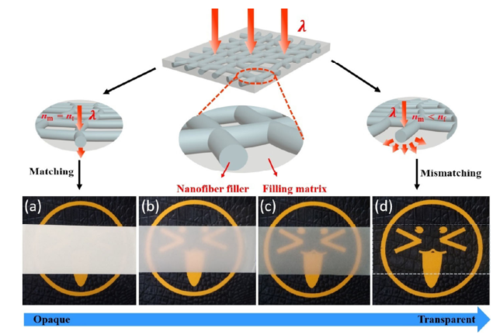Nanofiber-based transparent film with controllable optical transparency adjustment function for versatile bionic applications
ABSTRACT: As a new favorite in the field of smart materials, smart windows, with visual stimulus sensing functions, have attracted extensive attention for their high transparency, sensitive response to environmental stimulus, and reversible changes in light transmittance. In this paper, the PVA-co-PE nanofiber film, which was completely opaque like paper, was used as filling phase and reacted with water-soluble N-vinyl-2-pyrrolidone (NVP) by photopolymerization to produce a flexible transparency polyvinyl pyrrolidone/spraying PVA-co-PE nanofiber films (PVP/SPNFs) composite film. Among them, the small size effect of PVA-co-PE nanofibers played a pivotal role in improving the film’s transparency. Nevertheless, the PVP’s reversible adsorption–desorption behavior of water molecules made its refractive index change dynamically and reversibly, which led to the visual transition of composite film from transparent to opaque just like that of electronic smart windows. Additionally, the reversible transition rate of film’s transparency can be effectively regulated by the nanofiber stack structure. This new design of transparency visualization transforms composite film in response to humidity, innovates the electrically controlled smart windows on energy and realizes the effective utilization of natural resources such as water and humidity, which has a great application prospect in the field of flexible optoelectronic devices, intelligent buildings, and smart writing.

Wang Wen, et al. Nanofiber-based transparent film with controllable optical transparency adjustment function for versatile bionic applications. Nano Research [J]. 2021, 1-9.